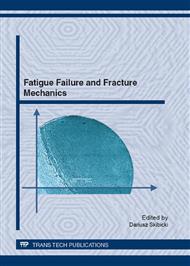p.39
p.43
p.51
p.55
p.63
p.69
p.77
p.84
p.93
Determination of the Fatigue Properties of Aluminum Alloy Using Mini Specimen
Abstract:
There are situations where taking normative specimens is impossible due to the dimensions of the objects investigated (e.g. extruded sections) and one of the solutions is to use mini specimens. As for non-standard specimen testing, it is essential to define the effect of size on fatigue strength. The research methodology facilitates the determination of fatigue characteristics (S-N) for EN AW-6063 aluminum alloy. The material is used to manufacture the extruded section in the process of extrusion of the material through the extruding die. The methodology assumes the geometry of the mini specimen and the normative specimen. As for the material strength identification, a static tensile test for the specimens made directly from finished elements and preliminarily strained in cycles was carried out. As a result of the cyclic material reinforcement, an increase in yield strength Re was observed, which, in turn, rejects Re as the upper criterion of the high-cycle fatigue range. The essential fatigue tests were performed based on unilateral cyclic tension (R = 0.1). The effect of size on fatigue strength was defined. Theoretically aluminum alloy non-sensitive to changes in the size of the cross-section showed a different strength in mini and normative specimens.
Info:
Periodical:
Pages:
63-68
Citation:
Online since:
August 2012
Authors:
Price:
Сopyright:
© 2012 Trans Tech Publications Ltd. All Rights Reserved
Share:
Citation:


